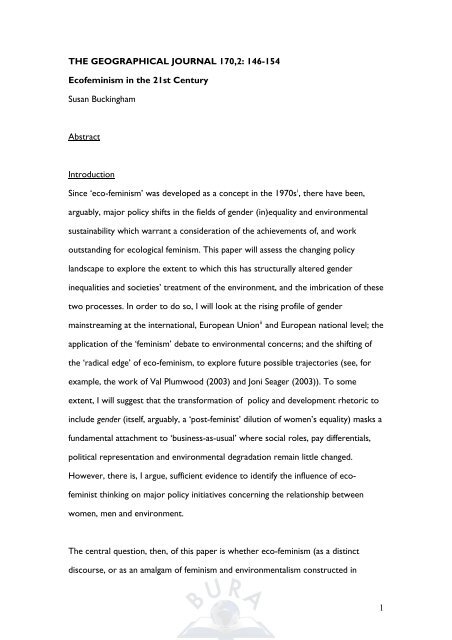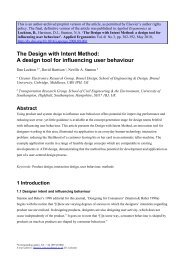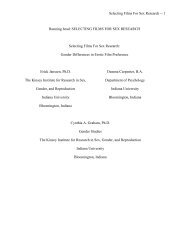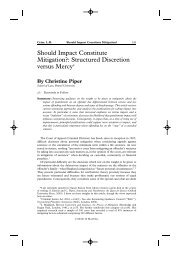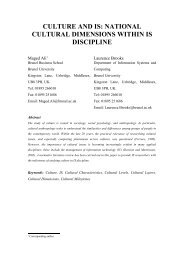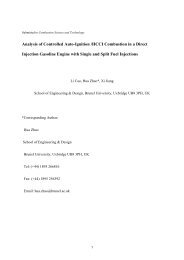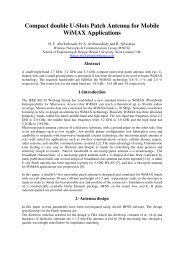Ecofeminism in the 21st Century
Ecofeminism in the 21st Century
Ecofeminism in the 21st Century
Create successful ePaper yourself
Turn your PDF publications into a flip-book with our unique Google optimized e-Paper software.
THE GEOGRAPHICAL JOURNAL 170,2: 146-154<br />
<strong>Ecofem<strong>in</strong>ism</strong> <strong>in</strong> <strong>the</strong> <strong>21st</strong> <strong>Century</strong><br />
Susan Buck<strong>in</strong>gham<br />
Abstract<br />
Introduction<br />
S<strong>in</strong>ce ‘eco-fem<strong>in</strong>ism’ was developed as a concept <strong>in</strong> <strong>the</strong> 1970s i , <strong>the</strong>re have been,<br />
arguably, major policy shifts <strong>in</strong> <strong>the</strong> fields of gender (<strong>in</strong>)equality and environmental<br />
susta<strong>in</strong>ability which warrant a consideration of <strong>the</strong> achievements of, and work<br />
outstand<strong>in</strong>g for ecological fem<strong>in</strong>ism. This paper will assess <strong>the</strong> chang<strong>in</strong>g policy<br />
landscape to explore <strong>the</strong> extent to which this has structurally altered gender<br />
<strong>in</strong>equalities and societies’ treatment of <strong>the</strong> environment, and <strong>the</strong> imbrication of <strong>the</strong>se<br />
two processes. In order to do so, I will look at <strong>the</strong> ris<strong>in</strong>g profile of gender<br />
ma<strong>in</strong>stream<strong>in</strong>g at <strong>the</strong> <strong>in</strong>ternational, European Union ii and European national level; <strong>the</strong><br />
application of <strong>the</strong> ‘fem<strong>in</strong>ism’ debate to environmental concerns; and <strong>the</strong> shift<strong>in</strong>g of<br />
<strong>the</strong> ‘radical edge’ of eco-fem<strong>in</strong>ism, to explore future possible trajectories (see, for<br />
example, <strong>the</strong> work of Val Plumwood (2003) and Joni Seager (2003)). To some<br />
extent, I will suggest that <strong>the</strong> transformation of policy and development rhetoric to<br />
<strong>in</strong>clude gender (itself, arguably, a ‘post-fem<strong>in</strong>ist’ dilution of women’s equality) masks a<br />
fundamental attachment to ‘bus<strong>in</strong>ess-as-usual’ where social roles, pay differentials,<br />
political representation and environmental degradation rema<strong>in</strong> little changed.<br />
However, <strong>the</strong>re is, I argue, sufficient evidence to identify <strong>the</strong> <strong>in</strong>fluence of eco-<br />
fem<strong>in</strong>ist th<strong>in</strong>k<strong>in</strong>g on major policy <strong>in</strong>itiatives concern<strong>in</strong>g <strong>the</strong> relationship between<br />
women, men and environment.<br />
The central question, <strong>the</strong>n, of this paper is whe<strong>the</strong>r eco-fem<strong>in</strong>ism (as a dist<strong>in</strong>ct<br />
discourse, or as an amalgam of fem<strong>in</strong>ism and environmentalism constructed <strong>in</strong><br />
1
different times and places <strong>in</strong> different ways) has changed <strong>the</strong> way <strong>in</strong> which Western<br />
society constructs <strong>the</strong> relationship between men, women and <strong>the</strong> environment. This,<br />
of course, is a problematic and speculative exercise and will follow from an analysis<br />
of how discourse and practice <strong>the</strong>mselves have changed.<br />
This paper will consider key changes to gender equality as it is l<strong>in</strong>ked to<br />
environmental susta<strong>in</strong>ability, and explore how women’s/fem<strong>in</strong>ists’ <strong>in</strong>terests have<br />
helped to shape <strong>the</strong> environmental debate <strong>in</strong> <strong>the</strong> past decade. I will try to unpick<br />
dom<strong>in</strong>ant discourses which, on <strong>the</strong> one hand are beg<strong>in</strong>n<strong>in</strong>g to ‘naturalize’ (some<br />
would say neutralize) environmental concerns (where <strong>the</strong> terms susta<strong>in</strong>able<br />
development and environmental susta<strong>in</strong>ability are common currency but poorly<br />
understood to <strong>the</strong> po<strong>in</strong>t of be<strong>in</strong>g anodyne), but on <strong>the</strong> o<strong>the</strong>r marg<strong>in</strong>aliz<strong>in</strong>g fem<strong>in</strong>ism,<br />
to exam<strong>in</strong>e <strong>the</strong> impact of this on ‘eco-fem<strong>in</strong>ism’. F<strong>in</strong>ally, I will explore <strong>the</strong> territory<br />
of eco-fem<strong>in</strong>ism’s lead<strong>in</strong>g/radical edge to speculate on where this may take both<br />
conceptual understand<strong>in</strong>g and policy <strong>in</strong> <strong>the</strong> future. First, however, to put this<br />
discussion <strong>in</strong>to context, I will briefly review eco-fem<strong>in</strong>ist arguments to illustrate <strong>the</strong>ir<br />
range, before focus<strong>in</strong>g on <strong>the</strong> constructivist approach, which has had <strong>the</strong> most<br />
traction <strong>in</strong> gender/environment debates <strong>in</strong> <strong>the</strong> last two decades.<br />
Eco-fem<strong>in</strong>ist approaches<br />
It is tempt<strong>in</strong>g to use a retrospective to try to impose some sort of order on past<br />
<strong>in</strong>tellectual activity and what I am attempt<strong>in</strong>g to do first <strong>in</strong> this article is to explore<br />
whe<strong>the</strong>r <strong>the</strong>re is an <strong>in</strong>tellectual trajectory, through a not necessarily coherent body<br />
of th<strong>in</strong>k<strong>in</strong>g and writ<strong>in</strong>g on gender and environment <strong>in</strong> <strong>the</strong> late 20 th century. In teas<strong>in</strong>g<br />
out <strong>the</strong> possible relationship between women’s position, gender relations, fem<strong>in</strong>ism,<br />
and <strong>the</strong> way <strong>in</strong> which Western society is seek<strong>in</strong>g to control or manage <strong>the</strong><br />
environment, eco-fem<strong>in</strong>ist writers <strong>in</strong> <strong>the</strong> 1970s and 1980s explored <strong>the</strong> relative<br />
importance of essentialism and social construction <strong>in</strong> <strong>the</strong>se relationships.<br />
2
The social constructivist analyses (which tended to dom<strong>in</strong>ate French and British<br />
writ<strong>in</strong>g, see, for example, Mary Mellor, 1992) drew from <strong>the</strong> Marxist and social<br />
fem<strong>in</strong>ist literature to show how women’s position <strong>in</strong> society (as, for example, carers<br />
of children and o<strong>the</strong>r vulnerable family members, domestic workers, and low<br />
paid/status workers) derived from prevail<strong>in</strong>g social and economic structures, which<br />
exposed <strong>the</strong>m to a particular set of environmental <strong>in</strong>civilities. The specifically eco-<br />
fem<strong>in</strong>ist argument here proposed that, s<strong>in</strong>ce <strong>the</strong> same social and economic<br />
structures also produced wide scale environmental damage, <strong>the</strong>n women could, <strong>in</strong><br />
some sense, ‘share’ this experience and were <strong>the</strong>refore better placed to argue on<br />
nature’s behalf.<br />
The essentialist argument that underp<strong>in</strong>ned some of <strong>the</strong> North American and<br />
Australian analyses proposed that women had a particular relationship with nature<br />
by virtue of <strong>the</strong>ir biology (predom<strong>in</strong>antly as actual or potential child bearers) and<br />
that this proximity to nature qualified <strong>the</strong>m to speak more eloquently on nature’s<br />
behalf. (See, for example, Charlene Spretnak, 1990 and Mary Daly, 1978.) Different<br />
authors drew on each position to different degrees, and much of <strong>the</strong> critique of eco-<br />
fem<strong>in</strong>ism (well articulated by Janet Biehl, 1991) over <strong>the</strong> past twenty years has<br />
focused on <strong>the</strong> problems perceived with essentialism, and on <strong>the</strong> validity of a shared<br />
experience between <strong>the</strong> human and non-human.<br />
Dennis Smith (2001), <strong>in</strong> discuss<strong>in</strong>g <strong>the</strong> role of gender <strong>in</strong> peace and conflict, has<br />
argued that essentialism is often used as a tool to mobilize a group around a<br />
perceived characteristic which sets it apart, and certa<strong>in</strong>ly, cultural eco-fem<strong>in</strong>ism<br />
(prioritiz<strong>in</strong>g essentialist arguments) did so. Its strength was to demonstrate <strong>the</strong><br />
possibility of a way of th<strong>in</strong>k<strong>in</strong>g and be<strong>in</strong>g which reversed <strong>the</strong> normal hierarchy <strong>in</strong><br />
which men stood at <strong>the</strong> peak; however, little academic fem<strong>in</strong>ist environmental<br />
3
th<strong>in</strong>k<strong>in</strong>g is currently framed <strong>in</strong> this way. Indeed, as Gillian Rose (1993) noted, to<br />
accept that women had an irreducible ‘female essence’ would be tantamount to<br />
admitt<strong>in</strong>g that o<strong>the</strong>rs dist<strong>in</strong>guished by ‘difference’ (such as m<strong>in</strong>ority ethnic<br />
populations, disabled people or gay men and women, and men more widely) could<br />
be driven to behave <strong>in</strong> similarly ‘essential’ ways, which, by def<strong>in</strong>ition, would be<br />
unchang<strong>in</strong>g and unchangeable, an argument that social scientists have been work<strong>in</strong>g<br />
hard to refute for many years.<br />
The argument that <strong>in</strong>forms this paper is based on an <strong>in</strong>terpretation of eco-fem<strong>in</strong>ism<br />
that is constructivist and it is certa<strong>in</strong>ly this strand that appears to have <strong>in</strong>formed<br />
policy development over <strong>the</strong> past twenty years.<br />
Changes <strong>in</strong> <strong>the</strong> Environmental Discourse: Policy<br />
By 2001, a paper <strong>in</strong> <strong>the</strong> Journal of Gender Studies was tak<strong>in</strong>g as axiomatic that<br />
governments throughout <strong>the</strong> world were beg<strong>in</strong>n<strong>in</strong>g to focus more attention on <strong>the</strong><br />
subject of gender equality (Bhattar, 2001:17). The follow<strong>in</strong>g reviews <strong>the</strong> extent to<br />
which, ma<strong>in</strong>ly <strong>in</strong>ter/transnational policy has accomplished this transition, whilst Table<br />
1 illustrates how both environmental policy and women’s equality policy have been<br />
dialectically affected by each o<strong>the</strong>r.<br />
Table 1: Strategies for L<strong>in</strong>k<strong>in</strong>g Women & Environment<br />
Br<strong>in</strong>g<strong>in</strong>g gender <strong>in</strong>to <strong>the</strong><br />
environment<br />
1992 United Nations Conference on<br />
Environment and Development<br />
2002 World Summit on Susta<strong>in</strong>able<br />
Development<br />
EU Gender Ma<strong>in</strong>stream<strong>in</strong>g DGXI<br />
Br<strong>in</strong>g<strong>in</strong>g <strong>the</strong> environment <strong>in</strong>to<br />
gender<br />
1995 United Nations 4 th Conference on<br />
Women and Platform of Action<br />
4
Environmental Justice movement<br />
One practice that has become much more widely embedded at national/<strong>in</strong>ternational<br />
level from <strong>the</strong> early 1990s is gender ma<strong>in</strong>stream<strong>in</strong>g iii . Framed with<strong>in</strong> human rights<br />
and equality discourses that have <strong>in</strong>formed <strong>the</strong> United Nations (UN), it has become<br />
a plank of all UN conventions s<strong>in</strong>ce <strong>the</strong> environment and women’s conferences of<br />
<strong>the</strong> early-mid 1990s. Jo<strong>in</strong>tly, <strong>the</strong> outcomes of <strong>the</strong>se two conferences (shown <strong>in</strong> Table<br />
1) have promoted <strong>the</strong> <strong>in</strong>clusion of environmental impacts and women’s <strong>in</strong>terests <strong>in</strong><br />
o<strong>the</strong>r UN agreements, such as those concern<strong>in</strong>g Habitat, Social Inclusion and<br />
Poverty. Whilst, arguably, <strong>the</strong> national mach<strong>in</strong>eries of <strong>the</strong> signatory states of <strong>the</strong>se<br />
conventions are necessary as catalysts for promot<strong>in</strong>g gender equality and justice,<br />
those same state structures are embedded <strong>in</strong> structural <strong>in</strong>equalities and it is<br />
sometimes difficult to see how <strong>the</strong>y may be used to make anyth<strong>in</strong>g o<strong>the</strong>r than<br />
superficial changes (Rai, 2003). Molyneaux (1998) dist<strong>in</strong>guishes between women’s<br />
‘practical’ and ‘strategic’ needs, whereby address<strong>in</strong>g such ‘practical’ needs as better<br />
childcare (or, <strong>in</strong> environmental terms, reduc<strong>in</strong>g nitrogen dioxide or particulate<br />
pollution as a contributor to childhood asthma) does noth<strong>in</strong>g to challenge exist<strong>in</strong>g<br />
power structures. However, strategic <strong>in</strong>terests (such as challeng<strong>in</strong>g a society which<br />
values <strong>the</strong> macho image of much car driv<strong>in</strong>g/ownership) take on exist<strong>in</strong>g patriarchal<br />
‘paradigms of power’. Rai argues that an effective way of gender ma<strong>in</strong>stream<strong>in</strong>g<br />
would be to frame women’s <strong>in</strong>terests (both practical and strategic) <strong>in</strong> <strong>the</strong> wider<br />
<strong>in</strong>terests of a just society ra<strong>the</strong>r than <strong>the</strong> commonly adopted additive nature of<br />
gender analysis.<br />
The United Nations Conference on Environment and Development <strong>in</strong> 1992 was <strong>the</strong><br />
first UN conference to be significantly <strong>in</strong>formed by <strong>the</strong> non-governmental sector. Its<br />
centrepiece (or at least, <strong>the</strong> element that achieved <strong>the</strong> most publicity, and was least<br />
5
sca<strong>the</strong>d by <strong>the</strong> Rio +5 evaluation, see Osborn and Bigg, 1998), Agenda 21, was a<br />
testament to <strong>the</strong> susta<strong>in</strong>ed lobby<strong>in</strong>g by women’s groups (as part of a wider NGO<br />
presence, and local government). The preparatory meet<strong>in</strong>gs took place across <strong>the</strong><br />
globe for two years and ensured a reasonably coherent lobby from <strong>the</strong><br />
women/environment movement worldwide, lead<strong>in</strong>g to <strong>the</strong> <strong>in</strong>clusion of a set of<br />
objectives def<strong>in</strong>ed <strong>in</strong> Chapter 24 ‘Global action for women towards susta<strong>in</strong>able<br />
development and equitable action’. (United Nations, 1992.)<br />
The l<strong>in</strong>k between women and <strong>the</strong> environment was consolidated, <strong>in</strong>ternationally, at<br />
<strong>the</strong> 1995 4 th United Nations Conference on Women <strong>in</strong> Beij<strong>in</strong>g. The result<strong>in</strong>g<br />
Platform for Action identified ‘Women and Environment’ as one of <strong>the</strong> critical areas<br />
of concern. UNED-UK’s ‘Gender 21’ group subdivided this concern <strong>in</strong>to: education;<br />
health; marg<strong>in</strong>alised groups; plann<strong>in</strong>g, hous<strong>in</strong>g and transport; Local Agenda 21 and<br />
consumption and waste (UNED-UK, 1997).<br />
Ten years later, <strong>the</strong> World Summit on Susta<strong>in</strong>able Development (WSSD) did little to<br />
advance women’s equality with respect to <strong>the</strong> environment, although <strong>the</strong> need to<br />
embed women’s (or sometimes termed, gendered) concerns was written more<br />
thoroughly <strong>in</strong>to <strong>the</strong> Plan of Implementation. Few achievements had been noted <strong>in</strong><br />
<strong>the</strong> <strong>in</strong>terven<strong>in</strong>g 10 years, for example, <strong>the</strong> UN had expressed frustration at <strong>the</strong> lack<br />
of progress on issues as wide as AIDS/HIV, globalization, poverty, and health – all of<br />
which are dist<strong>in</strong>guished by a gender dimension.<br />
Po<strong>in</strong>t 20 of The Johannesburg Declaration on Susta<strong>in</strong>able Development commits to<br />
ensur<strong>in</strong>g that “women’s empowerment and emancipation, and gender equality are<br />
<strong>in</strong>tegrated <strong>in</strong> all activities encompassed with<strong>in</strong> Agenda 21, The Millennium<br />
Development Goals and <strong>the</strong> Johannesburg Plan of Implementation”. This plan<br />
variously refers to women, females, women and men, and gender, both generally (as<br />
<strong>in</strong> “<strong>the</strong> outcomes of <strong>the</strong> summit should benefit all, <strong>in</strong>clud<strong>in</strong>g women...”), and with<br />
6
eference to specific programmes. Such programmes <strong>in</strong>clude good governance (item<br />
4), poverty eradication (item 6), elim<strong>in</strong>at<strong>in</strong>g violence (6), discrim<strong>in</strong>ation (6), health<br />
(6,46, 47), economic opportunity (6), land ownership (10a), water (24), agriculture<br />
(38f), technology (49), energy (49) and area specific programmes such as mounta<strong>in</strong><br />
areas and Africa (40c, 56). It also embeds gender considerations <strong>in</strong>to <strong>the</strong> means of<br />
implement<strong>in</strong>g <strong>the</strong> Plan, such as education, data collection, <strong>in</strong>dicator provision, public<br />
participation and decision mak<strong>in</strong>g. Such a thorough weav<strong>in</strong>g of gender/women<br />
throughout <strong>the</strong> Plan for Implementation is, <strong>in</strong> some ways, an improvement on <strong>the</strong><br />
targeted Chapter 24 focus<strong>in</strong>g on women <strong>in</strong> Agenda 21, but it is too soon to establish<br />
whe<strong>the</strong>r it will have any effect on signatory states’ treatment of women, particularly<br />
<strong>in</strong> relation to <strong>the</strong> environment. Participants <strong>in</strong> <strong>the</strong> Women’s Platform at <strong>the</strong> NGO<br />
Forum at WSSD had mixed reactions: both welcom<strong>in</strong>g a more thoroughly embedded<br />
<strong>in</strong>clusion of women <strong>in</strong> plans (WEDO, 2002) and exasperation at <strong>the</strong> assumption <strong>in</strong><br />
<strong>the</strong> ma<strong>in</strong> conference that ‘women’s issues’ had already been dealt with at Rio (WEN,<br />
European Group, 2002). There is some evidence that <strong>the</strong> women’s groups were<br />
right to be suspicious as, <strong>in</strong> preparation for <strong>the</strong> WSSD, <strong>the</strong> UN Commission for<br />
Susta<strong>in</strong>able Development, <strong>in</strong> its own preparatory committee, identified <strong>the</strong><br />
participation of women at all political levels as “still relatively low, and <strong>the</strong> level of<br />
participation at <strong>the</strong> <strong>in</strong>ternational level is not adequately geographically balanced or<br />
adequately f<strong>in</strong>anced”. (UN Economic and Social Council, 2002:43.)<br />
Gender ma<strong>in</strong>stream<strong>in</strong>g<br />
On <strong>the</strong> basis of <strong>the</strong> women’s groups <strong>in</strong>volved <strong>in</strong> submitt<strong>in</strong>g evidence to <strong>the</strong> United<br />
Nations preparatory committees, it could be argued that <strong>the</strong> <strong>in</strong>puts <strong>in</strong>to <strong>the</strong> UNCED<br />
and Beij<strong>in</strong>g conferences were <strong>in</strong>fluenced by <strong>the</strong> eco-fem<strong>in</strong>ist debates from <strong>the</strong> 1980s<br />
onwards. As such, it is possible to see how constructivist eco-fem<strong>in</strong>ism has been<br />
<strong>in</strong>corporated <strong>in</strong>to policy govern<strong>in</strong>g gender relations, environment, and <strong>the</strong> l<strong>in</strong>k<strong>in</strong>g of<br />
women and environment. One of <strong>the</strong>se outcomes is ‘gender ma<strong>in</strong>stream<strong>in</strong>g’.<br />
7
The United Nations pioneered ‘gender ma<strong>in</strong>stream<strong>in</strong>g’ which requested signatories<br />
of <strong>the</strong> 4 th World Conference on Women “to ma<strong>in</strong>stream a gender perspective <strong>in</strong>to<br />
all policies and programmes, so that, before decisions are taken, an analysis is made<br />
of <strong>the</strong> effects on women and men”(United Nations, 1995). Nanavaty (2001) reports<br />
ga<strong>in</strong>s at this level and makes recommendations as to how to achieve <strong>the</strong> attitude<br />
shift which will enable this. The European Union accepted <strong>the</strong> pr<strong>in</strong>ciple of gender<br />
ma<strong>in</strong>stream<strong>in</strong>g <strong>in</strong> 1996 and this has been formalised <strong>in</strong> <strong>the</strong> Treaty of Amsterdam,<br />
which commits member states to <strong>the</strong> “elim<strong>in</strong>ation of <strong>in</strong>equalities and <strong>the</strong> promotion<br />
of equality between women and men.” (European Union, 1997.) For example, a<br />
recent <strong>in</strong>vestigation of <strong>the</strong> gendered impact of waste management practice iv <strong>in</strong><br />
selected European Union member states illustrates <strong>the</strong> scope for this and <strong>the</strong> limited<br />
amount of good practice that is beg<strong>in</strong>n<strong>in</strong>g to emerge (see Buck<strong>in</strong>gham et al,<br />
forthcom<strong>in</strong>g), although it is also clear that <strong>the</strong> European Union commitment, and<br />
subsequent UK commitment to gender ma<strong>in</strong>stream<strong>in</strong>g through <strong>the</strong> Women and<br />
Equality Unit (1998) is not filter<strong>in</strong>g down to <strong>the</strong> local level of waste management <strong>in</strong><br />
anyth<strong>in</strong>g but a piecemeal fashion.<br />
The World Bank has identified practical reasons, consistent with its aims and<br />
practices, for <strong>in</strong>corporat<strong>in</strong>g gender equality <strong>in</strong>to its programmes. “Gender is an issue<br />
of development effectiveness, not just a matter of political correctness or k<strong>in</strong>dness<br />
to women. Evidence demonstrates that when women and men are relatively equal,<br />
economies tend to grow faster, <strong>the</strong> poor move more quickly out of poverty and <strong>the</strong><br />
well be<strong>in</strong>g of men, women and children is enhanced.” (World Bank, 2002.)<br />
Whilst most policy makers would not challenge <strong>the</strong>se aims, eco-fem<strong>in</strong>ists do<br />
question <strong>the</strong> validity of pursu<strong>in</strong>g economic growth, as much of this is likely to<br />
produce negative impacts on <strong>the</strong> environment. Their argument (see, for example,<br />
8
Mellor, 1992, Merchant, 1996, Plumwood, 1993) rests on chang<strong>in</strong>g our priorities<br />
whereby we may be driven more by quality of life issues, and that it is redistribution<br />
that should be at <strong>the</strong> heart of policy, ra<strong>the</strong>r than generat<strong>in</strong>g more growth. Eco-<br />
fem<strong>in</strong>ist literature suggests that women might be better able than men to effect this<br />
change, and that, <strong>the</strong>refore, it is not just a matter of equality with<strong>in</strong> exist<strong>in</strong>g<br />
structures, but of chang<strong>in</strong>g <strong>the</strong> structures to reflect this mode of th<strong>in</strong>k<strong>in</strong>g, a po<strong>in</strong>t<br />
that will be developed when consider<strong>in</strong>g future trajectories of eco-fem<strong>in</strong>ism. Bhattar<br />
(2001) argues that gender ma<strong>in</strong>stream<strong>in</strong>g, s<strong>in</strong>ce <strong>the</strong> 1980s, has sought to <strong>in</strong>tegrate<br />
gender concerns as part of ‘bus<strong>in</strong>ess as usual’, and that part of this approach has<br />
been to raise <strong>the</strong> number of female appo<strong>in</strong>tments to decision mak<strong>in</strong>g posts. Her<br />
reservations on this procedure are that this only works if women are able to<br />
“fundamentally re-orient <strong>the</strong> nature of <strong>the</strong> ma<strong>in</strong>stream” (2001:22), which requires all<br />
policy makers to accept that <strong>the</strong>re are “fundamental differences <strong>in</strong> <strong>the</strong> experience<br />
and <strong>in</strong>terpretation of reality between women and men” (2001:22). Unless policy<br />
makers are aware of this <strong>in</strong> advance, no amount of gender ma<strong>in</strong>stream<strong>in</strong>g <strong>in</strong>itiatives<br />
will make any difference. She argues that a ‘critical mass’ of women is needed <strong>in</strong><br />
decision mak<strong>in</strong>g fora to create <strong>the</strong> possibility for women to support each o<strong>the</strong>r <strong>in</strong><br />
policy <strong>in</strong>itiatives, to be a catalyst for o<strong>the</strong>r women to be <strong>in</strong>volved and to be <strong>in</strong> a<br />
position to allocate and control resources. A consensus seems to accumulate around<br />
a 30% to 35% m<strong>in</strong>imum ratio of women to men to create critical mass (see also<br />
Dahlerup, 1988; UNDAW, PRIO, 1996).<br />
Changes <strong>in</strong> Environmental Discourse: Environmental protest<br />
Rai (2003) argues that civil society (specifically women’s groups) is essential to<br />
streng<strong>the</strong>n <strong>the</strong> resolve of government to gender ma<strong>in</strong>stream, and to hold it to<br />
account. The degree to which any government is open to civil society scrut<strong>in</strong>y will<br />
determ<strong>in</strong>e <strong>the</strong> effectiveness of policy monitor<strong>in</strong>g. Indeed, as <strong>the</strong> above discussion<br />
9
shows, <strong>the</strong> global environmental debate has recognized <strong>the</strong> importance of enabl<strong>in</strong>g<br />
women and men to participate mean<strong>in</strong>gfully <strong>in</strong> environmental policy formation and<br />
decision mak<strong>in</strong>g through civil society structures, as well as through more formal<br />
representative structures. Such participation requires <strong>the</strong> means to access<br />
<strong>in</strong>formation which, <strong>in</strong> <strong>the</strong> third world, means elim<strong>in</strong>at<strong>in</strong>g <strong>in</strong>equalities <strong>in</strong> education<br />
from primary level. At present, <strong>the</strong> global adult literacy rate for men is 85%, whilst<br />
that for women is 74% (UN, ESC, 2002).<br />
Public participation usually relates to forms of democratic challenge which are<br />
formalized and structured <strong>in</strong> relation to state decision mak<strong>in</strong>g structures. Less formal<br />
expressions of political protest emerge when <strong>the</strong>se formalized structures of<br />
participation are found want<strong>in</strong>g – when fundamental breaches of ‘natural justice’ are<br />
as much <strong>the</strong> result of govern<strong>in</strong>g structures as <strong>the</strong>ir neglect. Such protests are more<br />
likely to be organized by women, <strong>the</strong>mselves on <strong>the</strong> marg<strong>in</strong>s of formal decision<br />
mak<strong>in</strong>g, and this has characterized <strong>the</strong> grass roots environmental movement <strong>in</strong><br />
disparate geographical locations. The early eco-fem<strong>in</strong>ist literature canonized<br />
‘movements’ such as <strong>the</strong> Chipco <strong>in</strong> Himalayan India, The Green Belt <strong>in</strong> Kenya, Love<br />
Canal <strong>in</strong> New York State and drew attention to <strong>the</strong> role of women <strong>in</strong> dramatiz<strong>in</strong>g<br />
<strong>the</strong> l<strong>in</strong>ks between environmental damage, <strong>the</strong> human impacts of this, women’s<br />
relative lack of power and <strong>the</strong> strategies this lack of power has necessitated. (See,<br />
respectively, Mies and Shiva 1993; Dankleman and Davidson, 1988; Gibbs, 1998).<br />
Wickramas<strong>in</strong>ghe l<strong>in</strong>ks <strong>the</strong> conceptual and practical aspects of eco-fem<strong>in</strong>ism <strong>in</strong> her<br />
work <strong>in</strong> South Asia, argu<strong>in</strong>g that this region, particularly <strong>in</strong> rural areas, has been at<br />
<strong>the</strong> centre of eco-fem<strong>in</strong>ism and that this has helped women conceptualise <strong>the</strong> l<strong>in</strong>ks<br />
between women and <strong>the</strong> environment. These <strong>in</strong>equalities – <strong>the</strong> gender gaps <strong>in</strong><br />
education, and <strong>the</strong> distribution of rural work – have not been eased by<br />
“development [but have been] re-endorsed <strong>in</strong> newly created development<br />
paradigms” (Wickramas<strong>in</strong>ghe, 2002: 230).<br />
10
What such movements lack <strong>in</strong> terms of f<strong>in</strong>ancial resources, <strong>the</strong>y make up for <strong>in</strong><br />
imag<strong>in</strong>ation and commitment and social cohesion. Indeed, Seager (2003) claims that<br />
“at its best, fem<strong>in</strong>ist environmentalism rocks boats” <strong>in</strong> a variety of policy and<br />
philosophical areas (p167). It comb<strong>in</strong>es <strong>the</strong>ory and activism to “challenge and<br />
redef<strong>in</strong>e foundational pr<strong>in</strong>ciples” (p167). In <strong>the</strong> United K<strong>in</strong>gdom, <strong>the</strong> Women’s<br />
Environmental Network, founded to counter what was seen as a mascul<strong>in</strong>ist bias <strong>in</strong><br />
environmental campaign<strong>in</strong>g v , has taken on issues that particularly affect women <strong>in</strong><br />
attention grabb<strong>in</strong>g campaigns such as ‘Gett<strong>in</strong>g Lippy’ (<strong>in</strong>vestigat<strong>in</strong>g chemically toxic<br />
<strong>in</strong>gredients <strong>in</strong> cosmetics), ‘Real Nappies’ (promot<strong>in</strong>g <strong>the</strong> use of cloth nappies to<br />
reduce <strong>the</strong> 8 million disposable nappies that are discarded, mostly to landfill, each<br />
day) and Chocolate (rais<strong>in</strong>g awareness of <strong>the</strong> toxic pesticide residues of l<strong>in</strong>dane<br />
which still exist <strong>in</strong> some non organic chocolate bars).<br />
CARTOON HERE.<br />
Whilst <strong>the</strong> l<strong>in</strong>k between poverty and women is not explicitly made, WEN’s work is<br />
founded on <strong>the</strong> understand<strong>in</strong>g that women are not well placed to argue with<strong>in</strong><br />
bus<strong>in</strong>ess or government and this has been borne out through several public battles<br />
with advertisers. Both <strong>the</strong> establishment of WEN <strong>in</strong> 1988 and its current practice is<br />
<strong>in</strong>formed by eco-fem<strong>in</strong>ism, which, through WEN’s <strong>in</strong>creas<strong>in</strong>gly ought after policy<br />
advisory role, is <strong>in</strong>directly f<strong>in</strong>d<strong>in</strong>g its way <strong>in</strong>to some UK government policy. In some<br />
ways, <strong>the</strong> example of WEN, illustrates <strong>the</strong> scope for more radical protest f<strong>in</strong>d<strong>in</strong>g its<br />
way <strong>in</strong>to public policy several years down <strong>the</strong> l<strong>in</strong>e. Their waste m<strong>in</strong>imization<br />
campaign demonstrates this as well, as WEN is now called to advise central<br />
government and local authorities, and has made a significant corrective <strong>in</strong>put <strong>in</strong> to<br />
<strong>the</strong> Greater London Authority’s Waste Plan. The challenge for WEN, as a multi-<br />
issue campaign<strong>in</strong>g organization is to comb<strong>in</strong>e work<strong>in</strong>g at <strong>the</strong> more radical eco-<br />
11
fem<strong>in</strong>ist edge, rais<strong>in</strong>g issues of salience to women, and often ignored <strong>in</strong> o<strong>the</strong>r policy<br />
fora, whilst reta<strong>in</strong><strong>in</strong>g an ability to have an <strong>in</strong>put <strong>in</strong>to government policy. This<br />
apparent conflict of balanc<strong>in</strong>g <strong>the</strong> radical and <strong>in</strong>corporation is well explored by Neil<br />
Carter (2001) with regard to <strong>the</strong> environmental movement more widely.<br />
Future trajectories for eco-fem<strong>in</strong>ism<br />
Environmental justice<br />
The environmental justice movement has grown <strong>in</strong> scope over <strong>the</strong> past two decades,<br />
emerg<strong>in</strong>g primarily from analyses of environmental <strong>in</strong>equalities based on<br />
race/ethnicity and poverty. Whilst eco-fem<strong>in</strong>ism has not claimed to be part of this, it<br />
clearly shares a number of its characteristics, not least, <strong>the</strong> fact that from <strong>the</strong> micro<br />
to <strong>the</strong> macro level, women are more likely than men to be classified as ‘<strong>in</strong> poverty’<br />
<strong>the</strong> world over. The environmental justice literature, previously dom<strong>in</strong>ated by<br />
poverty and race issues, is just beg<strong>in</strong>n<strong>in</strong>g to address gender. This is timely s<strong>in</strong>ce <strong>the</strong>re<br />
is accumulat<strong>in</strong>g evidence that gender is disproportionately associated with<br />
disadvantage <strong>in</strong> a number of ways. An Equal Opportunities Commission funded<br />
report recently found that even when controll<strong>in</strong>g for factors such as labour market<br />
status, age and number of children, household composition, and age, <strong>the</strong>re was still a<br />
clear gender dimension to poverty, and that women who are s<strong>in</strong>gle pensioners,<br />
unemployed, of Pakistani or Bangladeshi orig<strong>in</strong>, teenage householders and/or tenants,<br />
are more likely than men with <strong>the</strong> same characteristics to be poor (Bradshaw et al,<br />
2003). Such disadvantage has an impact on <strong>the</strong> extent to which <strong>the</strong>se women are<br />
trapped <strong>in</strong> poor quality environments. It is also noticeable how women, compared to<br />
men, are disproportionately disadvantaged <strong>in</strong> both chronic and catastrophic<br />
environmental hazard situations. Fordham (2003) identifies how this is both as a<br />
direct result of <strong>the</strong> hazard, for example, <strong>in</strong> <strong>the</strong> 1991 cyclone <strong>in</strong> Bangladesh which<br />
killed almost 140,000 people, 90% of <strong>the</strong> victims were women and children, or<br />
<strong>in</strong>directly. Here Fordham considers violence aga<strong>in</strong>st women which <strong>in</strong>creases <strong>in</strong> high<br />
12
stress situations, both <strong>in</strong> environmental catastrophes and chronically environmentally<br />
stressed situations, but which is largely ignored <strong>in</strong> <strong>the</strong> male dom<strong>in</strong>ated field of<br />
disaster management and development.<br />
Much of <strong>the</strong> eco-fem<strong>in</strong>ism literature refers to ‘embodiedment’ – or how women’s<br />
bodies are particularly vulnerable to environmental pollution (see, for example,<br />
Mellor,1992; Salleh, 1997), and yet historically, safe chemical loads have tended to be<br />
calculated on <strong>the</strong> basis of men’s body tolerance to exposure over an eight hour<br />
period (i.e. work time). New European legislation (such as REACH - The European<br />
Registration and Evaluation Authority for <strong>the</strong> Restriction of Chemicals) and recent<br />
publications, are beg<strong>in</strong>n<strong>in</strong>g to draw attention to <strong>the</strong> vulnerability of pregnant women<br />
(EEA, 2003), women more generally (EU) and women at different stages of <strong>the</strong>ir life<br />
cycle such as at puberty and menopause (Corra, <strong>in</strong> WEN, 2003). However, <strong>the</strong>re are<br />
still relatively few <strong>in</strong>stances of such recognition <strong>in</strong> <strong>the</strong> actual legislation. There is,<br />
consequently, significant scope to develop an environmental justice case along <strong>the</strong><br />
l<strong>in</strong>es that women are more vulnerable to toxic exposure both due to <strong>the</strong>ir social<br />
roles, which are more likely to consign <strong>the</strong>m to poverty than men, and <strong>the</strong>ir biology.<br />
Recent publications on environmental justice (see, for example, Agyeman, Bullard<br />
and Evans, 2002) are beg<strong>in</strong>n<strong>in</strong>g to <strong>in</strong>corporate concerns about women <strong>in</strong>to <strong>the</strong>ir<br />
analyses, and, more particularly, groups of women who are additionally marg<strong>in</strong>alized<br />
by <strong>the</strong>ir <strong>in</strong>come, occupation, ethnicity or disability. This is an important <strong>in</strong>clusion<br />
given that environmental justice issues are becom<strong>in</strong>g more widely heard and argued<br />
<strong>in</strong> North America and Europe.<br />
Non-human o<strong>the</strong>rs<br />
In 2003, two fem<strong>in</strong>ist/environmentalist writers published on <strong>the</strong> extension of<br />
fem<strong>in</strong>ist/environmental concerns <strong>in</strong>to animal rights. Joni Seager argued that a shared<br />
structure of oppression, a fem<strong>in</strong>ist analysis of allocation of rights and gendered<br />
13
assumptions about <strong>the</strong> relationship between human and non-human species<br />
underp<strong>in</strong>ned both eco-fem<strong>in</strong>ism and animal rights. (Seager, 2003.) Seager goes<br />
fur<strong>the</strong>r to suggest that both concerns share <strong>the</strong> problem of be<strong>in</strong>g consigned to a<br />
dualistic ‘o<strong>the</strong>r’ that, <strong>in</strong> reality, is more of a cont<strong>in</strong>uum (see also Haraway, 2000).<br />
Such extensions of fem<strong>in</strong>ist/environmentalist concerns reach <strong>in</strong>to debates <strong>in</strong>to food<br />
production systems and recreational activities such as hunt<strong>in</strong>g, both of which can be<br />
enriched, she argues, by an eco-fem<strong>in</strong>ist perspective.<br />
Likewise, Val Plumwood, who, <strong>in</strong> <strong>the</strong> 1990s argued for a dissolution of <strong>the</strong> dualistic<br />
way of see<strong>in</strong>g men and women (Plumwood, 1993), has extended this analysis to<br />
argue for a new ‘<strong>in</strong>ter-species’ ethic as <strong>the</strong> only way <strong>in</strong> which to avert what she sees<br />
as an ecological crisis, born of human hubris, sado-dispassion, rationality and a<br />
dualistic culture which has separated ‘Nature’ and ‘Culture’ <strong>in</strong> <strong>the</strong> West. Plumwood<br />
sees what/who she describes as <strong>the</strong> “Hero of Reason” (2003:21) as responsible for<br />
<strong>the</strong> “sado-dispassionate…cultural drama of reason and nature [unfold<strong>in</strong>g to] choke<br />
<strong>the</strong> life from his planetary partner <strong>in</strong> his f<strong>in</strong>al sadistic act of mastery.” (p22) Her aim<br />
is to provide “recipes for escap<strong>in</strong>g [this] situation” (p36) and she uses most of <strong>the</strong><br />
book to critique not only <strong>in</strong>dustrial and post-<strong>in</strong>dustrial approaches to <strong>the</strong> Earth and<br />
to what she variously refers to as Earth O<strong>the</strong>rs, supra-human, non-human and more-<br />
than-human (as alternative descriptors for life which is not classified as human), but<br />
also o<strong>the</strong>r spiritual traditions and approaches of deep ecology.<br />
Conclusions<br />
The relationship of <strong>the</strong> lead<strong>in</strong>g, or radical edge of any movement to <strong>the</strong> state is<br />
complex and <strong>in</strong>creas<strong>in</strong>gly well <strong>the</strong>orised (see, for example, Carter, 2001 Rootes,<br />
2001 on trad<strong>in</strong>g off radical action with <strong>in</strong>corporation). With regard to gender, Rai<br />
(2003) argues that, whilst it is important to work with<strong>in</strong> <strong>the</strong> state, such a strategy<br />
cannot be used exclusively, as <strong>the</strong> radical edge identifies <strong>the</strong> future, possibly,<br />
14
currently less politically acceptable challenges. This ‘radical edge’ has, I would argue,<br />
a particular salience with regard to environmental fem<strong>in</strong>ism, as protest and<br />
community politics is sometimes seen as <strong>the</strong> only way <strong>in</strong> which women, as a m<strong>in</strong>ority<br />
<strong>in</strong> decision mak<strong>in</strong>g arenas, can make <strong>the</strong>ir voice heard. This is as true with<strong>in</strong> <strong>the</strong><br />
academy (where both women, and fem<strong>in</strong>ist studies of one sort or ano<strong>the</strong>r, are<br />
marg<strong>in</strong>alized) as beyond.<br />
In look<strong>in</strong>g back, <strong>the</strong>n, over <strong>the</strong> past thirty years of eco-fem<strong>in</strong>ism, I would argue that<br />
significant strides have been made to <strong>in</strong>corporate women’s and gender issues with<strong>in</strong><br />
certa<strong>in</strong> policy areas and both <strong>the</strong> global and <strong>the</strong> local level. The evidence for this,<br />
where this exists, lies <strong>in</strong> <strong>the</strong> campaign<strong>in</strong>g groups who have <strong>in</strong>formed <strong>in</strong>ternational<br />
agreements and local practice. This is, of course, particularly so where <strong>the</strong> aims of<br />
<strong>the</strong>se groups have co<strong>in</strong>cided with <strong>the</strong> practical aims of <strong>in</strong>ternational and aid agencies<br />
(such as Oxfam or <strong>the</strong> World Bank). However, real obstacles rema<strong>in</strong> <strong>in</strong> mak<strong>in</strong>g<br />
structural changes to social systems to ensure that equality and fem<strong>in</strong>ist concerns<br />
are rout<strong>in</strong>ely part of environmental decision mak<strong>in</strong>g and eco-fem<strong>in</strong>ist <strong>the</strong>oreticians<br />
and activists cont<strong>in</strong>ue to expose <strong>the</strong>se concerns.<br />
REFERENCES<br />
Agyeman Julian, Bullard, Robert D and Evans Bob 2003 Just Susta<strong>in</strong>abilities,<br />
development <strong>in</strong> an unequal world London/Cambridge, MA: Earthscan/MIT Press<br />
Bhatta Gambhir 2001 Of Geese and Ganders: ma<strong>in</strong>stream<strong>in</strong>g gender <strong>in</strong> <strong>the</strong> context<br />
of susta<strong>in</strong>able human development Journal of Gender Studies 10,1<br />
Biehl Janet 1991 Reth<strong>in</strong>k<strong>in</strong>g Fem<strong>in</strong>ist Politics South End Books, Boston, MA<br />
Bradshaw Jonathan, F<strong>in</strong>ch Naomi, Kemp Peter A, Mayhew Emese and Williams, Julie<br />
15
2003 Gender and Poverty <strong>in</strong> Brita<strong>in</strong> Manchester: Equal Opportnities Commission<br />
Buck<strong>in</strong>gham Susan and Reeves Dory 2004 Title Report to <strong>the</strong> CEC Directorate<br />
General Environment<br />
Carter Neil 2001 The Politics of <strong>the</strong> Environment Cambridge: Cambridge University<br />
Press<br />
Corra Lilian 2003 <strong>in</strong> Demand a Toxic Free future <strong>in</strong> WEN News Autumn 2003<br />
Cruse Amy, Flenley Clare, Hemmati, M<strong>in</strong>u 2000 Section K: Women and <strong>the</strong><br />
Environment. An outcome of <strong>the</strong> three phase consultation process with UK NGOs to assess<br />
<strong>the</strong> implementation of <strong>the</strong> Beij<strong>in</strong>g Platform for Action (Section K) over <strong>the</strong> last 5<br />
years.London: UNED-UK/Gender 21<br />
Dahlerup Drude 1988 From a small to a large m<strong>in</strong>ority: women <strong>in</strong> Scand<strong>in</strong>avian<br />
Politics Scand<strong>in</strong>avian Political Studies 11,4<br />
Daly Mary 1978 Gyn/ecology: <strong>the</strong> metaethics of Radical Fem<strong>in</strong>ism London: Women’s<br />
Press<br />
Dankleman Irene and Davidson Joan 1988 Women and Environment <strong>in</strong> <strong>the</strong> Third<br />
World, alliance for <strong>the</strong> future London: Earthscan<br />
European Union 1997 Treaty of Amsterdam (OJ C 340, 10.11.1997)<br />
Fordham Maureen 2003 Gender, disaster and development: <strong>the</strong> necessity for<br />
<strong>in</strong>tegration <strong>in</strong> Pell<strong>in</strong>g M ed Natural Disastersand Development <strong>in</strong> a Globaliz<strong>in</strong>g World<br />
London: Routledge<br />
Gibbs Lois 1998 Love Canal, <strong>the</strong> story cont<strong>in</strong>ues Gabriola Island, BC, Canada: New<br />
Society Press<br />
Mellor Mary 1992 Break<strong>in</strong>g <strong>the</strong> Boundaries, towards a fem<strong>in</strong>ist green socialism London:<br />
Virago Press<br />
Merchant Carolyn 1996 Earthcare, women and <strong>the</strong> environment London: Routledge<br />
Middleton Neil and O’Keefe Phil 2003 Rio plus Ten. Politics, poverty and <strong>the</strong><br />
environment London: Pluto Press<br />
Mies Maria and Shiva Vandana 1993 <strong>Ecofem<strong>in</strong>ism</strong> London: Zed Books<br />
16
Molyneaux Max<strong>in</strong>e 1998 Analys<strong>in</strong>g Women’s Movements Development and Change<br />
Vol 29<br />
Osborn Derek and Bigg Tom 1998 Earth Summit II, outcomes and analyses London:<br />
Earthscan<br />
Plumwood Val 2002 Environmental Culture, <strong>the</strong> ecological crisis of reason London:<br />
Routledge<br />
Plumwood Val 1993 Fem<strong>in</strong>ism and <strong>the</strong> Mastery of Nature London: Routledge<br />
Rootes Christopher Environmental Politics<br />
Rai Shir<strong>in</strong> M 2003 Institutional mechanisms for <strong>the</strong> advancement of women:<br />
ma<strong>in</strong>stream<strong>in</strong>g gender, democratiz<strong>in</strong>g <strong>the</strong> state? <strong>in</strong> Rai S ed Ma<strong>in</strong>stream<strong>in</strong>g gender,<br />
democratiz<strong>in</strong>g <strong>the</strong> state? Institutional mechanisms for <strong>the</strong> advancement of women<br />
Manchester: Manchester University Press<br />
Rose Gillian 1993 Fem<strong>in</strong>ism and Geography: <strong>the</strong> limits of geographical knowledge<br />
Cambridge: Polity Press<br />
Salleh Ariel 1997 <strong>Ecofem<strong>in</strong>ism</strong> as Politics; nature, Marx and <strong>the</strong> postmodern London: Zed<br />
Books<br />
Seager Joni 2003 Pepperoni or Broccoli? On <strong>the</strong> Cutt<strong>in</strong>g Wedge of Fem<strong>in</strong>ist<br />
Environmentalism Gender, Place, Culture 10,2<br />
Smith Dan 2001 The Problems of Essentialism <strong>in</strong> Skjelsbaek and Smith Dan eds<br />
Gender, Peace and Conflict London: Sage<br />
United Nations Economic and Social Council 2001 Commission on Susta<strong>in</strong>able<br />
Development act<strong>in</strong>g as <strong>the</strong> preparatory committee for <strong>the</strong> World Summitt on Susta<strong>in</strong>able<br />
Development: Implement<strong>in</strong>g Agenda 21, Report of <strong>the</strong> Secretary-General New York:<br />
United Nations<br />
United Nations General Assembly 2000 Ten year review of progress achieved <strong>in</strong> <strong>the</strong><br />
implementation of <strong>the</strong> outcome of <strong>the</strong> United Nations Conference on Environment and<br />
Development New York: United Nations<br />
UNDAW & PRIO 1996 Political decision mak<strong>in</strong>g and conflict resolution: <strong>the</strong> impact of<br />
17
gender difference Expert Group Meet<strong>in</strong>g <strong>in</strong> Santo Dom<strong>in</strong>go, Dom<strong>in</strong>ican Republic 7-11<br />
October EGM/PRDC/1996/REP.1 New York: UN Division for <strong>the</strong> Advancement of<br />
Women<br />
Wickramas<strong>in</strong>ghe Anoya 2003 Women and Environmental Justice <strong>in</strong> South Asia <strong>in</strong><br />
Agyeman J, Bullard R, Evans B ibid<br />
i Eco-fem<strong>in</strong>ism as a neologism was conceived by Francoise D’Eubonne to signify <strong>the</strong> conjo<strong>in</strong><strong>in</strong>g of<br />
radical ecological and fem<strong>in</strong>ist th<strong>in</strong>k<strong>in</strong>g <strong>in</strong> a variety of perspectives which sought to elim<strong>in</strong>ate gender<br />
<strong>in</strong>equalities and hierarchies <strong>in</strong> a way that valued <strong>the</strong> environment, and articulated parallels between<br />
women’s and environmental exploitation.<br />
ii The reason for focus<strong>in</strong>g on EU and its member states is twofold: firstly, EU policy has been<br />
committed to gender ma<strong>in</strong>stream<strong>in</strong>g for 8 years, which gives a certa<strong>in</strong> perspective from which<br />
toconsider its efficacy; secondly, <strong>the</strong> author’s own research is focused on Europe, and specifically on<br />
gender ma<strong>in</strong>stream<strong>in</strong>g <strong>in</strong> environmental policy.<br />
iii UN DAW has def<strong>in</strong>ed this as “<strong>the</strong> process of assess<strong>in</strong>g <strong>the</strong> implications for women and men of any<br />
planned action, <strong>in</strong>clud<strong>in</strong>g legislation, policies or programmes, <strong>in</strong> all areas and at all levels. It is a<br />
strategy of mak<strong>in</strong>g women’s as well as men’s concerns and experiences an <strong>in</strong>tegral dimension of <strong>the</strong><br />
design, implementation, monitor<strong>in</strong>g and evaluation of policies and programmes <strong>in</strong> all political,<br />
economic and societal spheres so that women and men benefit equally and <strong>in</strong>equality is not<br />
perpetuated. The ultimate goal is to achieve gender equality”. (<strong>in</strong> Shir<strong>in</strong> Rai, 2003)<br />
iv Study <strong>in</strong>to Gender-Differentiated Impacts of Municipal Waste Management Plann<strong>in</strong>g <strong>in</strong> <strong>the</strong> EU fro<br />
The Commission of <strong>the</strong> European Communities, Directorate General Environment ENV A Contract:<br />
B4-3040/2002/343154/MAR/A2<br />
v For details about WEN contact <strong>in</strong>fo@wen.org.uk<br />
18


